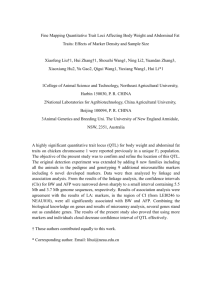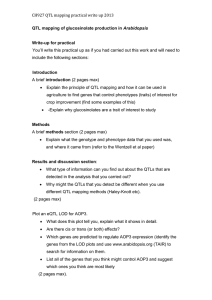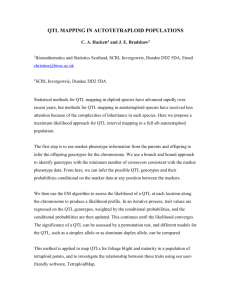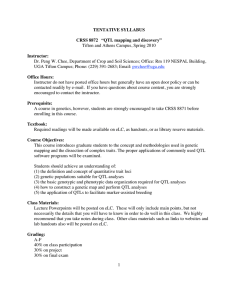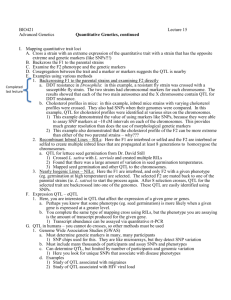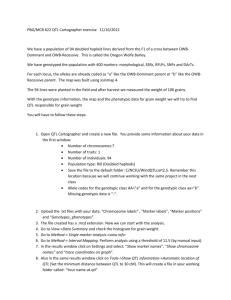QTL Mapping and Marker-Assisted Selection Jack Dekkers Ans653A lecture 2010
advertisement
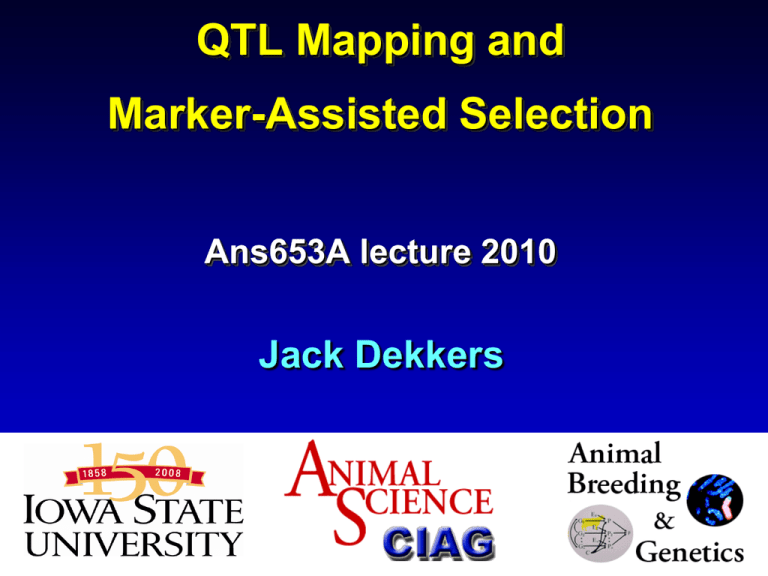
QTL Mapping and Marker-Assisted Selection Ans653A lecture 2010 Jack Dekkers Past and Current Selection Strategies selection Black box of Genes h2 Phenotype Quantitative genetics Environment Estimated Breeding Value Phenotype of relatives Molecular Genetics “In Search of the Holy Grail” M Q M Q M Q m q m q m q Major genes Quantitative Trait Loci (QTL) = position (locus) on genome associated with genetic differences for a quantitative trait Use of Molecular Data in Selection Unknown genes Molec. Phenotypic data ? genetics Genes QTL Phenotype EBV Molecular data Selection strategy Markerbased EBV Advantage of Molecular Genetic data for selection Genes Molecular genetics • Heritability of genotypes = 1 QTL • Expressed in both sexes • Expressed at early age • Requires less phenotypic data From Molecular Genetics to Marker-Assisted Selection Four Key Areas of R&D: 1) Molecular genetics - molecular markers - genetic maps 2) QTL or major gene detection 3) Use of gene / marker data in breeding value estimation 4) Use of gene / marker data in selection Outline • Strategies and designs for QTL mapping • QTL mapping in breed crosses • Within-breed QTL mapping • Half-sib designs • Linkage disequilibrium mapping • candidate genes • high-density SNP panels • Marker-assisted genetic evaluation • Use of markers in selection • MAS • Marker-assisted composite line development • Genomic selection • MAS for commercial crossbred performance Suggested Reading • USDA-NSIF QTL mapping and MAS conference 2003 NSIF conference proceedings: http://www.nsif.com/Conferences/2003/contents.html • in particular the chapter on MAS • Dekkers and van der Werf (2007) Chapter 10 at http://www.fao.org/docrep/010/a1120e/a1120e00.htm • Dekkers (2010) Use of high-density marker genotyping for genetic improvement. CAB Reviews. http://www.cabi.org/cabreviews/ShowPDF.aspx?PAN=20103261356 • Goddard and Hayes. 2009 Nature Reviews: Genetics 10: 381 Principle of QTL detection Mean weight 105 (kg) M Q M Q 100 M Q m q 95 m q m q 1. Genotype pigs for marker(s) 2. Test for association between marker genotype and phenotype Presence of association requires not only linkage but also linkage disequilibrium between marker and QTL Processes that create LD Mutation M Q M Q M MQ q Selection Crossing M Q M QQ M M Q Inbreeding/drift m q m q X m q m q m q m q M Q m q M Q m q M Q m q M Q M Q M Q m q M Q m q m q m q Measure of LD r = correlation betw. Alleles 11 00 01 10 00 11 01 Example LD in outbred population 1 1 c=.001 c=.01 0.9 0.8 0.7 0.6 0.5 0.9 0.4 c=.2 0.3 c=.05 c=.1 0.2 0.1 0 0.8 0 5 10 15 Generation 0.7 r-squared 0.6 0.5 0.4 0.3 0.2 0.1 0 0 5000 10000 15000 20000 25000 30000 Distance (kb) 35000 40000 45000 50000 20 25 But LD always exists within families Half-sib family QTL mapping design r = 0.2 M Q Sire m Half-sib Progeny M 1/ M Q 2(1-r)= Freq. m meiosis M 0.4 q 1/ 2r q =0.1 m 1/ 2(1-r)= m q 0.4 Freq. Q 1/ 2r= Prob(Q|M received from sire) = 0.8 Marker and QTL are in LD among progeny 0.1 Strategies for QTL mapping in livestock Outbred population Breed cross c =.001 c =.01 LD c =.05 c =.2 0 c =.1 5 10 15 20 25 Generation LD used Recomb. LD extent Marker map Coverage Map resol. Linkage analysis LD markers Linkage analysis LE markers F2 / BC HS/FS AIL families LD mapping LD markers Cand. pedigree genes Ext. High density QTL detection in F2 breed cross Genome Scan for Pork Quality Massoud Malek Hauke Thomsen Jong-Joo Kim Hong-hua Zhao Max Rothschild Rohan Fernando Jack Dekkers Berkshire x F2 cross Yorkshire Cross creates extensive Linkage Disequilibrium M Q M Q M Q M QQ M M MQ q m q M Q m q M Q m q r=.001 r=.01 r=.05 r=.1 r=.2 0.9 0.8 0.7 0.6 0.5 0.4 0.3 0.2 0 5 10 15 Generation 20 25 m q m q m q M Q m q M Q M Q M Q 0.1 0 m q M Q m q 1 X m q m q M Q m q m q 10-20 cM marker distance sufficient F0 2 Berkshire sires M1 N1 BB 9 Yorkshire dams x YY M2 N2 M1 N1 F1 F2 M2 N2 8 sires BY x BY 26 dams M1 N1 M1 N1 M2 N2 M2 N2 525 Breed origin probabilities BB BY YB YY M1 N1 M1 N1 M2 N2 M1 N1 M2 N2 M2 N2 PBB PBY PYB PYY derived for a given position SSC1 MARBLING 4.5 -logP 4.0 3.5 http://www.animalgenome.org/QTLdb/pig.html Line-Cross BB = - 0.13 BY = +0.19 YY = +0.13 1% Chr.w Malek et al. 2001 3.0 2.5 5% Chr.w 2.0 1.5 1.0 0.5 Detect QTL that differ in 0.0 cM frequency 0 10 20 30 40 between 50 60 70 80 breeds 90 100 110 120 130 Breed cross QTL scan F0 2 Berkshire sires BB 9 Yorkshire dams x YY F1 x F2 8 sires 525 BB BY BY BY 26 dams YB YY QTL that differ in frequency between breeds Wide QTL region (20-50 cM) LD-markers for - introgression - composite development (see later) BUT: Within-breed MAS requires QTL that segregate within breeds Follow-up within-breed research in QTL region - QTL mapping - candidate genes Within-breed QTL mapping Half-sib family design r = 0.2 M Q Sire m Half-sib Progeny M 1/ M Q 2(1-r)= Freq. m meiosis M 0.4 q 1/ 2r q =0.1 m 1/ 2(1-r)= m q 0.4 Freq. Q 1/ 2r= Prob(Q|M received from sire) = 0.8 Marker and QTL are in LD among progeny 0.1 Halfsib design for QTL detection and MAS Mm M M M M M M M M M m m m m m m m m m Compare production Problem: within-family LD is not consistent across families Sire 1 Sire 2 Sire 3 Sire 4 M Q M q M Q M q m q m Q m Q m q Analysis must allow for different marker-QTL linkage phases within each family Linkage phase = assortment of alleles into haplotypes Sire 1 has genotypes Mm and Qq; haplotypes MQ and mq Within breed QTL detection Half-sib analysis confirm w/in breed segregation of QTL Evans et al. (2003 Genetics:621) - confirmed QTL in 10 commercial lines - Does not narrow QTL region LD mapping or association analysis – find markers close enough to the QTL, such that associations are consistent across the population (pop-wide LD) Candidate gene approach High density SNP panels GWAS Example LD in outbred population 1 1 c=.001 c=.01 0.9 0.8 0.7 0.6 0.5 0.9 0.4 c=.2 0.3 c=.05 c=.1 0.2 0.1 0 0.8 0 5 10 15 Generation 0.7 r-squared 0.6 0.5 0.4 0.3 0.2 0.1 0 0 5000 10000 15000 20000 25000 30000 Distance (kb) 35000 40000 45000 50000 20 25 Since 2000: A Revolution in Molecular Technology 2.8 million SNPs Nature 2004 Single Nucleotide Polymorphisms High-through-put SNP genotyping International Swine Genome Sequencing Consortium NOW AVAILABLE: AAGCCTTGATAATT Illumina Porcine 60k Beadchip maternal paternal AAGCCTTGCTAATT + discovery of many Single Nucleotide SNPs Polymorphisms 60,000 DNA tests for <$250 Genomic Selection How to use high-density SNP data? Genotype large # of Individuals for large numbers of SNPs + collect their phenotypes Statistical Analysis to detect QTL / estimate SNP effects (GWAS) Use only significant SNPs for MAS Allows detecting more LD markers but still suffers from only using significant markers • Small effects are missed • Beavis effect 1 r=.001 r=.01 0.9 0.8 0.7 0.6 Summary of QTL mapping strategies r=.05 r=.1 r=.2 0.5 0.4 0.3 0.2 Outbred population Breed cross Linkage analysis Assoc.analysis LD mapping 0.1 0 0 5 10 15 20 Generation 25 F2 / BC AIL HS/FS families Cand. pedigree genes Ext. LD used Population wide in cross Recomb. 1 rnd >1 rnd 1 rnd >1 rnd LD extent Long Smaller Long Smaller Denser Sparse Denser Marker map Sparse Coverage Map resol. Genome wide Poor Better Population wide Within family Genome wide Poor Better High density >>> 1 round Small Few loci Dense Local Genome High LD-LA analysis Summary QTL mapping Breed cross QTL scan QTL that differ between breeds Wide QTL regions LD-markers within cross - use for introgression, composite development Within-breed QTL scan QTL that segregate within breeds Wide QTL regions LE-markers - difficult for MAS Candidate gene approach LD-markers for within-breed MAS High-density genotyping LD mapping (GWAS) LD-markers for within-breed MAS So you‟ve found a QTL ........ Now what ?? Use of Molecular Genetics in Breeding Programs Jack Dekkers Department of Animal Science Center for Integrated Animal Genomics QTL detection 3 types of selectable loci Direct markers LD-markers Functional mutations - known genes q In pop.-wide Linkage Disequilibrium with mutation Linkage phase ~consistent across population LE-markers Q MQ MQ mq MQ mq mq In pop.-wide Linkage Equilibrium with mutation Linkage phase NOT consistent across families Sire 2 Sire 1 Sire 3 Sire 4 M Q M q M Q M q m q m Q m Q m q Outline • Strategies and designs for QTL mapping • QTL mapping in breed crosses • Within-breed QTL mapping • Half-sib designs • Linkage disequilibrium mapping • candidate genes • high-density SNP panels • Marker-assisted genetic evaluation • Use of markers in selection • MAS • Marker-assisted composite line development • Genomic selection • MAS for commercial crossbred performance Genes and LD-Markers Linkage phase tends to be consistent across families and generations MQ MQ mq MQ mq mq Include marker genotype(s) as fixed effect in animal model y = marker genotype + a + e Estimate effects in population under selection Must be re-estimate on a regular basis LE-markers Linkage phase not consistent between sires Sire 1 Sire 2 Sire 3 Sire 4 M Q M q M Q M q m q m Q m Q m q QTL effect must be estimated for each individual/family • Based on family information • • marker genotypes phenotypes LE-markers Marker-assisted BLUP (Fernando and Grossman, 1989, GSE) Sire Dam M s Q sp Md Qdp M s Q sm Md Qdm Progeny Ms Qip M d Q im ^ m + u^ Total EBV = v^ip + v i yi = m + vip + vim + u + e Paternal / Maternal PolyQTL allele effect genic Var(u) = Asu2 Var(v) = Gsv2 G = gametic relationship matrix for QTL effects Computed from - marker genotypes - marker-QTL rec. rate Examples of gene tests in commercial breeding Trait Congenital defects Appearance Milk quality D = dairy cattle B = beef cattle C = poultry P = pigs S = sheep Dekkers, 2004, JAS “MAS has seen limited application” Meat quality Direct marker BLAD (D) Citrulinaemia (D,B) DUMPS (D) CVM (D) Maple syrup urine (D,B) Mannosidosis (D,B) RYR (P) CKIT (P) MC1R/MSHR (P,B,D) MGF (B) -Casein (D) -lactoglobulin (D) FMO3 (D) RYR (P) RN/PRKAG3 (P) LD marker LE marker RYR (P) Polled (B) RYR (P) RN/PRKAG3 (P) A-FABP/FABP4 (P) H-FABP/FABP3 (P) CAST (P, B) >15 PICmarqTM (P) THYR (B) Leptin (B) Feed intake Disease Reproduction Growth & composition Milk yield & composition MC4R (P) Prp (S) F18 (P) Booroola (S) Inverdale(S) Hanna (S) MC4R (P) IGF-2 (P) Myostatin (B) Callipyge (S) DGAT (D) GRH (D) -Casein (D) B blood group (C) K88 (P) Booroola (S) ESR (P) PRLR (P) RBP4 (P) CAST (P) IGF-2 (P) QTL (P) QTL (B) Carwell (S) PRL (D) QTL (D) Reasons for limited use of MAS in livestock • • • • # markers available is limited Markers only explain limited % of genetic variance • Only QTL with moderate – large effects detected Genotyping costs Marker/QTL effects are not consistent / not transferable to commercial breeding populations • • • • „Beavis‟ effect – effects of „significant‟ markers tend to be overestimated Marker effects were estimated within families or in experimental crosses Interactions of marker/QTL effects with genetic background and / or environment Inconsistent marker-QTL LD across populations Outline • Strategies and designs for QTL mapping • QTL mapping in breed crosses • Within-breed QTL mapping • Half-sib designs • Linkage disequilibrium mapping • candidate genes • high-density SNP panels • Marker-assisted genetic evaluation • Use of markers in selection • MAS • Marker-assisted composite line development • Genomic selection • MAS for commercial crossbred performance Use of Molecular Data in Selection Unknown genes Molec. Phenotypic data ? genetics Genes QTL Phenotype EBV Molecular data Selection strategy Markerbased EBV Example Marker-based EBV based on 3 SNPs ^ for # A alleles) of: with estimated effects ( +10 for SNP 1 + 5 for SNP 2 –10 for SNP 3 MarkerSNP 1 SNP 2 SNP 3 based Individual Genotype Value Genotype Value Genotype Value EBV 1 AA 10 AA 5 AA -10 5 2 AA 10 AA 5 BB 10 25 3 AB 0 BB -5 AB 0 -5 4 AB 0 BB -5 AA -10 -15 5 BB -10 AA 5 AB 0 -5 Possible Selection strategies • Select on Marker-based EBV alone • Tandem selection • Index selection • Pre-selection 1) MAS (index) at young age 2) Select on EBV at later age E.g. Pre-selection for Entry into Testing Program Testing program Pre-selection for Entry into Testing Program Q q q Q q q Q q Q q q Q Q Testing program QTL Pre-selection Testing program QTL variance = 20% Merit of boars entered 2.0 1.8 1.6 1.4 No pre-selection 1.2 1.0 0.8 0.6 0.4 0.2 0.0 100 No preselection 50 33 25 % pre-selected based on QTL QTL Pre-selection Testing program QTL variance = 20% Merit of boars entered 2.0 With pre-selection 1.8 1.6 1.4 No pre-selection 1.2 1.0 0.8 0.6 0.4 0.2 0.0 100 No preselection 50 33 25 % pre-selected based on QTL Potential gains from MAS in livestock Meuwissen & Goddard, 1996 (GSE) Selection on MA-BLUP EBV (= index) QTL with 1/3 of genetic variance haplotype-marked h2=.27 64 70 MAS is most beneficial for „difficult‟ traits 62 55 60 50 38 38 40 39 37 31 30 30 25 21 20 15 10 9 5 0 1 4 2 2 Generation 3 5 Trait characteristic Carcass trait Sex-limited trait Phenotyped after selection Phenotyped before selection Gains from LE-MAS Effect of Heritability (Meuwissen & Goddard 1996) Single marked QTL with 1/3 of genetic variance 70 60 45 50 36 38 34 40 30 23 25 30 21 15 17 20 13 9 10 6 5 4 0 1 2 2 Generation 3 5 h2=.11 h2=.27 Phenotyping after h2=.11 Phenotyping before h2=.27 Gains from MAS Effect of QTL effect (Meuwissen & Goddard 1996) Phenotyping after selection. Heritability=32% 70 60 47 40 50 33 40 29 25 23 30 19 13 20 12 12 10 10 5 0 1 7 5 4 2 3 Generation 4 5 46.7 26.7 13.3 6.7 MAS for meat quality Meuwissen & Goddard, 1996 (GSE) QTL with 1/3 of genetic variance haplotype-marked h2=.27 Two scenarios 1. Random 2/4 from each litter slaughtered for meat quality. Remaining littermates are selected on the basis of a MAEBV for meat quality, once data on their sibs is recorded. 2. Animals are selected on the basis a MA-EBV and nonselected animals are slaughtered to provide data for the next generation of selection 70 64 62 Extra response from MAS (%) 60 55 50 40 39 30 24 23 20 25 22 10 0 Strategy 2 1 Strategy 1 2 Generation 3 5 Fat allele higher BF Lean allele IGF-2 lower LEA Only paternal allele is expressed (imprinting) Tactical use in cross breeding FF LL X LL FL X Terminal progeny LF LL All Lean Fat sufficient reserves Outline • Strategies and designs for QTL mapping • QTL mapping in breed crosses • Within-breed QTL mapping • Half-sib designs • Linkage disequilibrium mapping • candidate genes • high-density SNP panels • Marker-assisted genetic evaluation • Use of markers in selection • MAS • Genomic selection • MAS for commercial crossbred performance Since 2000: A Revolution in Molecular Technology 2.8 million SNPs Nature 2004 Single Nucleotide Polymorphisms High-through-put SNP genotyping International Swine Genome Sequencing Consortium NOW AVAILABLE: AAGCCTTGATAATT Illumina Porcine 60k Beadchip maternal paternal AAGCCTTGCTAATT + discovery of many Single Nucleotide SNPs Polymorphisms 60,000 DNA tests for <$250 Genomic Selection Genomic Selection in outbred population Meuwissen et al. (2001) Genotype Many SNPs Genotype for SNPs Genotype for SNPs MODEL to predict phenotype/BV from SNP genotypes Predict BV or phenotype Accuracy Phenotype 1.0 0.8 0.6 3 4 5 6 Generation 7 8 How to use high-density SNP data? Genotype large # of Individuals for large numbers of SNPs + collect their phenotypes Statistical Analysis to detect QTL / estimate SNP effects Use only significant SNPs for MAS Allows detecting more LD markers but still suffers from only using significant markers • Small effects are missed • Beavis effect Solution: Genomic selection Meuwissen et al. 2001 Genetics Genetic Evaluation using high-density SNPs • All SNPs are fitted simultaneously, i.e. 50,000 vs. 1 at a time • SNP effects are fitted as random vs. fixed effects • enables all SNPs to be fitted simultaneously • shrinks SNP effect estimates to 0 depending on evidence from data yi = m + S SNP k k gik + ei ^ Estimates of SNP effects k Implemented using a variety of Bayesian methods (Bayes-A, -B, -C) Or by using genomic vs. pedigree relationships in animal model BLUP (GBLUP) Use to estimate breeding value of new animals based on genotypes alone Genomic EBV = S ^ g k ik 1000 Predictor Predictee >3,500 progeny-tested bulls 800 Young 600 400 200 2008 2006 2004 2002 2000 1998 1996 1994 1992 1990 1970 0 1950 Number of Animals Data used to develop Genomic predictions in Holsteins Year of Birth National Swine Improvement Federation Symposium, Dec. 2008 (55) Paul VanRaden 2008 Genomic EBV have greater reliability for young bulls and heifers than Parent Average EBV E.g. for Young Holstein Bulls (VanRaden and Tooker, 2009 USDA-AIPL) ftp://aipl.arsusda.gov/pub/outgoing/GenomicReliability0608.doc Trait Net merit Milk yield Fat yield Protein yield Productive life Dtr. Pregancy rate Gain over parent average reliability (~39%) + 23 + 32 + 36 + 28 + 33 + 20 Genomic Selection (GS) •GS provides unique opportunities to enhance breeding programs by: • increasing / maintaining response to selection • reducing rates of inbreeding • reducing loss of favorable alleles • reducing generation intervals • limiting need for pedigree-based phenotypes GS requires large training populations Goddard and Hayes. 2009 Nature Reviews: Genetics 10: 381 Sample size depends on the extent of LD in the population, which depends (historical) effective population size (Ne) and on trait heritability Outline • Strategies and designs for QTL mapping • QTL mapping in breed crosses • Within-breed QTL mapping • Half-sib designs • Linkage disequilibrium mapping • candidate genes • high-density SNP panels • Marker-assisted genetic evaluation • Use of markers in selection • MAS • Genomic selection • MAS for commercial crossbred performance Current Pyramid Selection Programs Limitations: - limited selection for performance in the field - no selection for traits not recorded in nucleus - disease traits NUCLEUS herds Sire line Multiplier Dam line Multiplier Production herds High health environment rg < 1 Field environment Selection for Performance in Field „Traditional‟ Breeding Solution: Field data on relatives Collect phenotypes on relatives in field Combined Crossbred-Purebred Selection Purebred data Sire line DGfield DF Bijma & van Arendonk, „98 Requirements/limitations: - Costly logistics - Pedigree-based phenotyping in field Multiplier - Longer generation intervals - Higher rates of inbreeding - family data vs. own phenotype Production herds Selection for Performance in Field Possible Molecular Genetic Solution: Markerassisted EBV Identify markers with effects on performance in the field MAS/GS MAS Advantages: Markerbased EBV Sire line Genotype Current limitations: Multiplier SNP effect estimates - No pedigree-based phenotypes - Reduce generation intervals - Select for low heritable traits Genotype Phenotype - Few useful markers available - Most detected in purebreds - Effects not consistent across breeds and environments Production herds Genomic Selection for Field Performance Potential benefits Markerassisted EBV Genomic selection EBV MAS/GS Genetic correlation (purebred – commercial) = 0.7 Sire line Genotype Multiplier SNP effect estimates Genotype Phenotype (Dekkers 2007 JAS) Production herds Accuracy of selection Selection for commercial performance for Accuracy field performance of selection r =0.7 Accuracy Dekkers JAS, 2007 pb,cb by Crossbred Genomic Selection (GSXb) 0.8 0.7 0.6 0.5 PPb+ PXbred 0.4 PPurebred 0.3 0.2 0.1 0.2 0.3 0.4 0.5 0.6 Accuracy of GS-EBV 0.7 0.8 Accuracy of selection Selection for commercial performance for Accuracy field performance of selection r =0.7 Accuracy Dekkers JAS, 2007 pb,cb by Crossbred Genomic Selection (GSXb) 0.8 0.7 0.6 0.5 PPb+ PXbred 0.4 GSPb PPurebred 0.3 0.2 0.1 0.2 0.3 0.4 0.5 0.6 Accuracy of GS-EBV 0.7 0.8 Accuracy of selection Selection for commercial performance for Accuracy field performance of selection r =0.7 Accuracy Dekkers JAS, 2007 pb,cb by Crossbred Genomic Selection (GSXb) 0.8 0.7 GSXb 0.6 0.5 PPb+ PXbred 0.4 GSPb PPurebred 0.3 0.2 0.1 0.2 0.3 0.4 0.5 0.6 Accuracy of GS-EBV 0.7 0.8 Accuracy of selection Selection for commercial performance for field ofperformance Accuracy selection r pb,cb=0.7 Accuracy Dekkers JAS, 2007 by Crossbred Genomic Selection PPb+GSXb (GSXb) 0.8 GSXb 0.7 0.6 0.5 PPb+ PXbred 0.4 GSPb PPurebred 0.3 0.2 0.1 0.2 0.3 0.4 0.5 0.6 Accuracy of GS-EBV 0.7 0.8 Impact on Inbreeding DF (%) Dekkers JAS, 2007 Crossbred Genomic Selection (GSXb) 3.5 PPb+ PXbred 3 2.5 PPurebred 2 1.5 1 0.5 0.2 0.3 0.4 0.5 0.6 Accuracy of GS-EBV 0.7 0.8 Impact on Inbreeding DF (%) Dekkers JAS, 2007 Crossbred Genomic Selection (GSXb) 3.5 PPb+ PXbred 3 2.5 PPurebred 2 1.5 1 GSXb 0.5 0.2 0.3 0.4 0.5 0.6 Accuracy of GS-EBV 0.7 0.8 Impact on Inbreeding DF (%) Dekkers JAS, 2007 Crossbred Genomic Selection (GSXb) 3.5 PPb+ PXbred 3 2.5 PPurebred 2 1.5 PPb+GSXb 1 GSXb 0.5 0.2 0.3 0.4 0.5 0.6 Accuracy of GS-EBV 0.7 0.8 8 Partial LD Estimation q 6 4 of marker q Q q 2 effects in Q q q Q Q Q crosses GG GA AA Sire Dam GG GA AA 10 Complete LD 6 GQ Aq line line Multiplier Multiplier GQ Aq Production herds 9 q Marker effects differ between purebreds vs. crossbreds 6.5 Q 5.5 q Reasons: 3 Q Q Q Q q q Q q q GG GA AG AA Dominance Epistasis GxEnvironment Marker-QTL LD Genomic selection in crossbred populations Methods Founders 1 M chromosome 500 -6000 SNPs 100 QTL h2=0.3 Bayes-B 1000 generations Ne = 500 Ali Toosi, Noelia Ibañez, Rohan Fernando, Jack Dekkers Breed A Breed B 50 generations Ne = 100 50 generations Ne = 100 Training data sets N=1000 Breed B Breed A Mix A+B NRI Award 2007-35205-17862 Breed C 8 generations Ne = 100 F1 AxB Breed B validation C(AB) F2 AxB Accuracy of GS based on admixed training populations 0.9 # markers on 1 M chrom. 0.8 0.6 500 0.5 0.4 0.3 0.2 0.1 Training populations ) )(C D (A B )C (A B X AM ) )(A B (A B AB A+ B A 0 B Accuracy 0.7 74 Accuracy of GS based on admixed training populations 0.9 0.8 # markers on 1 M chrom. 0.6 0.5 500 2000 0.4 0.3 0.2 0.1 Training populations ) )(C D (A B )C (A B X AM ) )(A B (A B AB A+ B A 0 B Accuracy 0.7 75 Summary / Conclusions HD SNP genotyping offers unique opportunities to enhance animal breeding programs by removing limitations on when, where, and on whom phenotypes are recorded • Genomic selection of purebreds for field performance of crossbreds • With opportunities to • reduce generation intervals • reduce inbreeding • Detect QTL for animal health • Select for animal health Simulation results look very promising Empirical results are becoming available Concluding remarks Recent advances in genotyping technology and reduced costs have increased opportunities for MAS • Use of LD- instead of LE-markers • Use all vs only significant markers (?) • genomic selection • MAS on commercial performance • Increases response • Reduces rate of inbreeding • Requires continued emphasis on phenotypic recording • Requires careful economic analysis Integration in breeding & business goals Phenotype LE markers LD markers Monogenic traits Genes Costs Risks Polygenic traits BLUP EBV Breeding Business goal Selection strategy Genotype (prob) Genetic gain Market share Differentiation Implementation of MAS requires comprehensive approach Business R&D objectives Farms DNA collection Phenotyping Pedigree Genotyping Genotypic Database Phenotypic Database Analytical tools Selection
